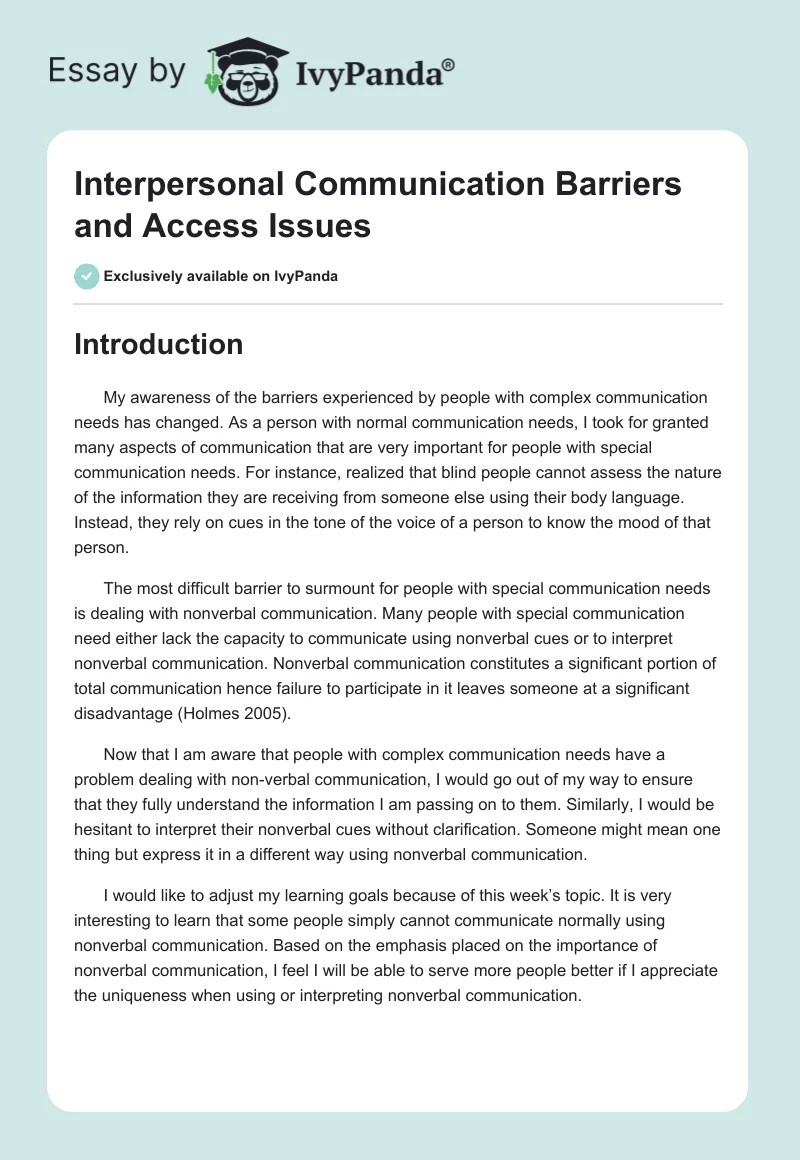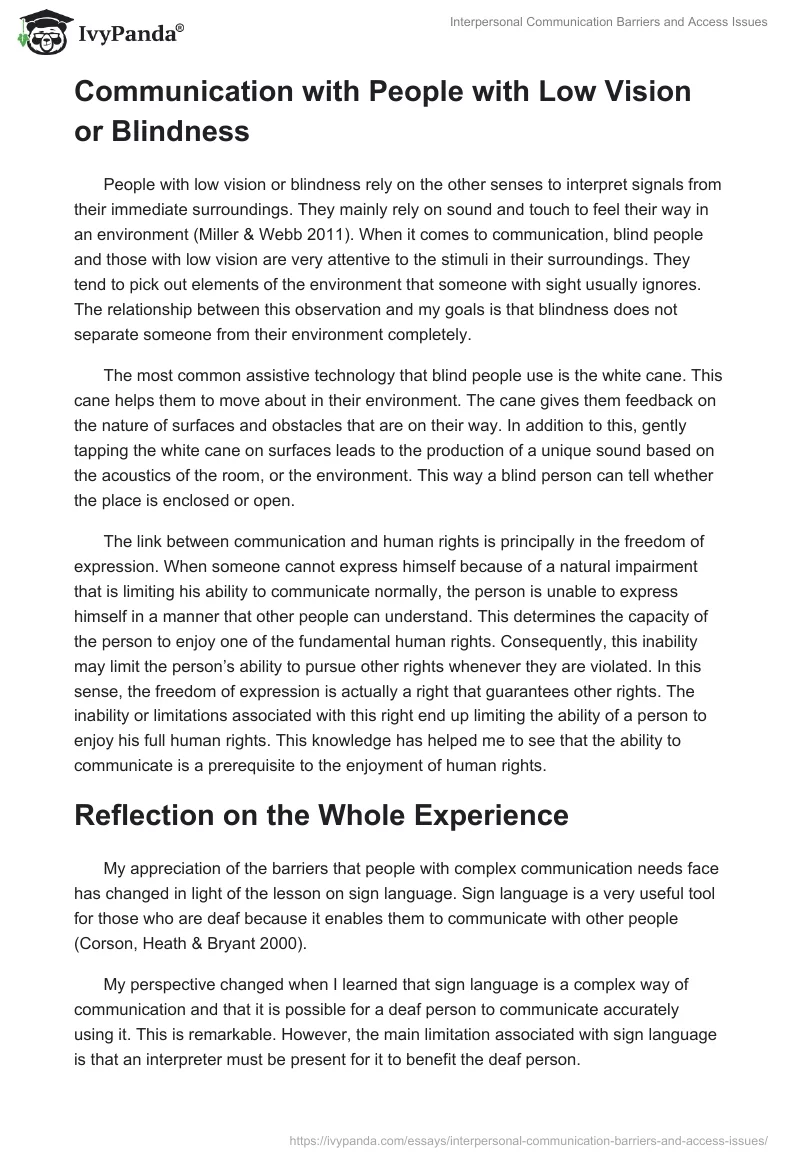Introduction
My awareness of the barriers experienced by people with complex communication needs has changed. As a person with normal communication needs, I took for granted many aspects of communication that are very important for people with special communication needs. For instance, realized that blind people cannot assess the nature of the information they are receiving from someone else using their body language. Instead, they rely on cues in the tone of the voice of a person to know the mood of that person.
The most difficult barrier to surmount for people with special communication needs is dealing with nonverbal communication. Many people with special communication need either lack the capacity to communicate using nonverbal cues or to interpret nonverbal communication. Nonverbal communication constitutes a significant portion of total communication hence failure to participate in it leaves someone at a significant disadvantage (Holmes 2005).
Now that I am aware that people with complex communication needs have a problem dealing with non-verbal communication, I would go out of my way to ensure that they fully understand the information I am passing on to them. Similarly, I would be hesitant to interpret their nonverbal cues without clarification. Someone might mean one thing but express it in a different way using nonverbal communication.
I would like to adjust my learning goals because of this week’s topic. It is very interesting to learn that some people simply cannot communicate normally using nonverbal communication. Based on the emphasis placed on the importance of nonverbal communication, I feel I will be able to serve more people better if I appreciate the uniqueness when using or interpreting nonverbal communication.
Communication with People with Low Vision or Blindness
People with low vision or blindness rely on the other senses to interpret signals from their immediate surroundings. They mainly rely on sound and touch to feel their way in an environment (Miller & Webb 2011). When it comes to communication, blind people and those with low vision are very attentive to the stimuli in their surroundings. They tend to pick out elements of the environment that someone with sight usually ignores. The relationship between this observation and my goals is that blindness does not separate someone from their environment completely.
The most common assistive technology that blind people use is the white cane. This cane helps them to move about in their environment. The cane gives them feedback on the nature of surfaces and obstacles that are on their way. In addition to this, gently tapping the white cane on surfaces leads to the production of a unique sound based on the acoustics of the room, or the environment. This way a blind person can tell whether the place is enclosed or open.
The link between communication and human rights is principally in the freedom of expression. When someone cannot express himself because of a natural impairment that is limiting his ability to communicate normally, the person is unable to express himself in a manner that other people can understand. This determines the capacity of the person to enjoy one of the fundamental human rights. Consequently, this inability may limit the person’s ability to pursue other rights whenever they are violated. In this sense, the freedom of expression is actually a right that guarantees other rights. The inability or limitations associated with this right end up limiting the ability of a person to enjoy his full human rights. This knowledge has helped me to see that the ability to communicate is a prerequisite to the enjoyment of human rights.
Reflection on the Whole Experience
My appreciation of the barriers that people with complex communication needs face has changed in light of the lesson on sign language. Sign language is a very useful tool for those who are deaf because it enables them to communicate with other people (Corson, Heath & Bryant 2000).
My perspective changed when I learned that sign language is a complex way of communication and that it is possible for a deaf person to communicate accurately using it. This is remarkable. However, the main limitation associated with sign language is that an interpreter must be present for it to benefit the deaf person.
The lesson I learned about sign language helped me to know that there is a proper means of communication with deaf people. In this sense, I will not need to feel frustrated when I meet a deaf person because it is possible to communicate with this person.
In my work and in my relationships, I learned that sign language could help me to relate well with the deaf. This means that if I end up working or living within close confines to a deaf person, it is possible to communicate with the person.
The main lesson that will help my profession is that I can interact with a deaf person and deaf colleagues as long as I can interpret sign language. This will normalize my relationships with people with special communications needs.
I learned to communicate a few things in sign language. This was unexpected. Since sign language is a symbolic language, I picked up a few things that can start as a conversation opener with a deaf person.
Reference List
Corson, D, Heath, RL & Bryant, J 2000, Human Communication Theory and Research: Concepts, Context, and Challenges, 2nd end, Lawrence Erlbaum Associates, Inc, Mahwah, NJ.
Holmes, D 2005, Communication Theory: Media, Technology, and Society, SAGE, London, UK.
Miller, E & Webb, L 2011, ‘Active Listening and Attending: Communication Skills and the Healthcare Environement’, in Nursing: Communication Skills for Practice, Oxford University Press, Oxford.


